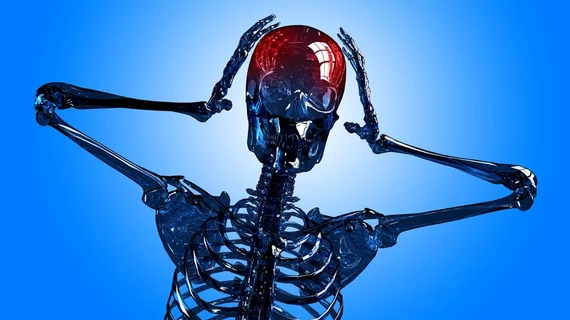Emergency department CT offers little value for most migraine patients
Although Variant 3 of the American College of Radiology (ACR) Appropriateness Criteria recommends performing non-contrast head CT (NCCT) on patients with sudden severe headache who do not present other high-risk features, researchers from the department of radiology at Johns Hopkins Medical Center in Baltimore, Maryland found that performing emergency department (ED) NCCT scans on these patents has little value.
The findings, detailed in a study published online Jan. 17 in the Journal of the American College of Radiology, determined that the value of repetitive NCCT scans in patients with sudden sever headache—commonly called "worst headache of life" (WHOL) or "thunderclap headache" (TCH)—is limited unless the patient has a known history of intracranial pathology, cancer or has suffered recent head trauma.
“Given the low yield of NCCT, one must reconsider whether the ACR Appropriateness Criteria recommendation to scan patients with the ‘red flag’ of Variant 3, WHOL or TCH, should pertain to the chronic migraine patient population,” the researchers wrote.
For their study, the team reviewed ED NCCT scans conducted over a five-year period in 224 patients with histories of WHOL or TCH and who were diagnosed with a migraine.
The patients and their respective scans were split into two groups: 132 patients without known histories of intracranial pathology, cancer or immunocompromising disease or recent head trauma (main study group) and 92 patients with positive histories of any of those factors (comparing group).
The scans were then graded by an attending neuroradiologist with 30 years of experience as either “normal” (1), having “minor unimportant findings” (2), “findings requiring intervention or follow-up" (3) or “critical” (4).
In the main study group, no patients had grade 4 imaging findings, one had a false-positive grade 3 finding (0.8 percent) and there were no cases of subarachnoid hemorrhage, according to the researchers. As for the comparison group, six patients had grade 4 findings (6.5 percent) and three had grade 3 findings (3.3 percent).
“On the basis of our findings, we believe that imaging in migraineurs should be limited to those individuals who have not previously been imaged. If a migraineur has had recent negative imaging findings and WHOL or TCH, and subarachnoid hemorrhage is still suspected, a lumbar puncture initially may be warranted,” the researchers concluded.

